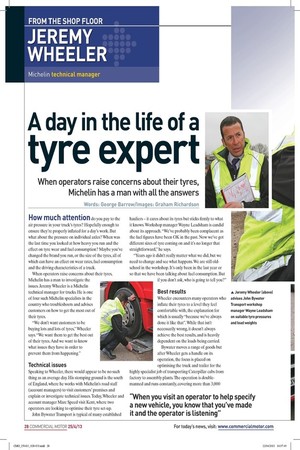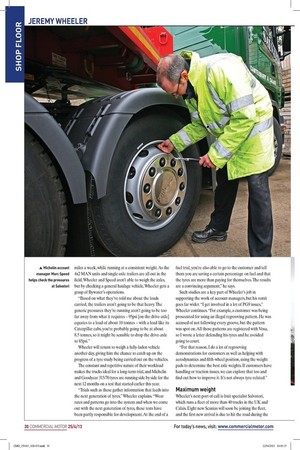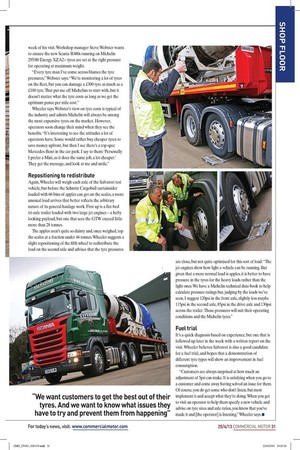A day in the life of a tyre expert When
Page 19

Page 21

Page 22

If you've noticed an error in this article please click here to report it so we can fix it.
operators raise concerns about their tyres, Michelin has a man with all the answers Wø 1 ua. vcul uranam Klliiai uauil How much attention do you pay to the air pressure in your truck's tyres? Hopefully enough to ensure they're properly inflated for a day's work. But what about the pressure on individual axles? When was the last time you looked at how heavy you run and the effect on tyre wear and fuel consumption? Maybe you've changed the brand you run, or the size of the tyres, all of which can have an effect on wear rates, fuel consumption and the driving characteristics of a truck.
When operators raise concerns about their tyres, Michelin has a man to investigate the issues. Jeremy Wheeler is a Michelin technical manager for trucks. He is one of four such Michelin specialists in the country who troubleshoots and advises customers on how to get the most out of their tyres.
"We don't want customers to be buying lots and lots of tyres," Wheeler says. "We want them to get the best out of their tyres. And we want to know what issues they have in order to prevent them from happening."
Technical issues Speaking to Wheeler, there would appear to be no such thing as an average day. His stomping ground is the south of England, where he works with Michelin's road staff (account managers) to visit customers' premises and explain or investigate technical issues. Today, Wheeler and account manager Marc Speed visit Kent, where two operators are looking to optimise their tyre set-up.
John Bywater Transport is typical of many established hauliers — it cares about its tyres but sticks firmly to what it knows. Workshop manager Wayne L,eadsham is candid about its approach. "We've probably been complacent as the fuel figures have been OK in the past. Now we've got different sizes of tyre coming on and it's no longer that straightforward," he says.
"Years ago it didn't really matter what we did, but we need to change and see what happens. We are still oldschool in the workshop. It's only been in the last year or so that we have been talking about fuel consumption. But if you don't ask, who is going to tell you?"
Best results Wheeler encounters many operators who inflate their tyres to a level they feel comfortable with, the explanation for which is usually "because we've always done it like that". While that isn't necessarily wrong, it doesn't always achieve the best results, and is heavily dependent on the loads being carried. miles a week, while running at a consistent weight. As the 4x2 MAN units and single-axle trailers are all out in the field, Wheeler and Speed aren't able to weigh the axles, but by checking a general haulage vehicle, Wheeler gets a grasp of Bywater's operations.
"Based on what they've told me about the loads carried, the trailers aren't going to be that heavy. The generic pressures they're running aren't going to be too far away from what it requires — 95psi [on the drive-axle] equates to a load of about 10 tonnes — with a load like its Caterpillar cabs, you're probably going to be at about 8.5 tonnes, so it might be sensible to drop the drive-axle to 85psi."
Wheeler will return to weigh a fully-laden vehicle another day, giving him the chance to catch up on the progress of a tyre study being carried out on the vehicles.
The constant and repetitive nature of their workload makes the trucks ideal for a long-term trial, and Michelin and Goodyear 315/70 tyres are running side by side for the next 12 months on a test that started earlier this year.
"Trials such as these gather information that feeds into the next generation of tyres," Wheeler explains. "Wear rates and patterns go into the system and when we come out with the next generation of tyres, these tests have been partly responsible for development. At the end of a fuel trial, you're also able to go to the customer and tell them you are saving a certain percentage on fuel and that the tyres are more than paying for themselves. The results are a convincing argument," he says.
Such studies are a key part of Wheeler's job in supporting the work of account managers, but his remit goes far wider. "I get involved in a lot of PG9 issues," Wheeler continues. "For example, a customer was being prosecuted for using an illegal regrooving pattern. He was accused of not following every groove, but the pattern was spot on. All those patterns are registered with Vosa, so I wrote a letter defending his tyres and he avoided going to court.
"For that reason, I do a lot of regrooving demonstrations for customers as well as helping with aerodynamics and fifth-wheel position, using the weight pads to determine the best axle weights. If customers have handling or traction issues, we can explore that too and find out how to improve it. It's not always tyre-related."
Maximum weight Wheeler's next port of call is fruit specialist Salvatori, which runs a fleet of more than 40 trucks in the UK and Calais. Eight new Scanias will soon be joining the fleet, and the first new arrival is due to hit the road during the week of his visit. Workshop manager Steve Webster wants to ensure the new Scania R480s running on Michelin 295/80 Energy XZA2+ tyres are set at the right pressure for operating at maximum weight.
"Every tyre man I've come across blames the tyre pressures," Webster says. "We're monitoring a lot of tyres on the fleet, but you can damage a £300 tyre as much as a £100 tyre. That put me off Michelins to start with, but it doesn't matter what the tyre costs as long as we get the optimum pence per mile cost."
Wheeler says Webster's view on tyre costs is typical of the industry and admits Michelin will always be among the most expensive tyres on the market. However, operators soon change their mind when they see the benefits. "It's interesting to see the attitudes a lot of operators have. Some would rather buy cheaper tyres to save money upfront, but then I see there's a top-spec Mercedes-Benz in the car park. I say to them: 'Personally I prefer a Mini, as it does the same job, a lot cheaper.' They get the message, and look at me and smile."
Repositioning to redistribute Again, Wheeler will weigh each axle of the Salvatori test vehicle, but before the Schmitz Cargobull curtainsider loaded with 66 bins of apples can get on the scales, a more unusual load arrives that better reflects the arbitrary nature of its general haulage work. First up is a flat-bed tri-axle trailer loaded with two large jet engines — a hefty looking payload, but one that sees the GTW exceed little more than 28 tonnes.
The apples aren't quite so dainty and, once weighed, top the scales at a fraction under 44 tonnes. Wheeler suggests a slight repositioning of the fifth wheel to redistribute the load on the second axle and advises that the tyre pressures are close, but not quite optimised for this sort of load. "The jet engines show how light a vehicle can be running. But given that a more normal load is apples, it is better to have pressure in the tyres for the heavy loads rather than the light ones. We have a Michelin technical data book to help calculate pressure ratings but, judging by the loads we've seen, I suggest 120psi in the front axle, slightly less maybe 115psi in the second axle, 85psi in the drive axle and 130psi across the trailer. Those pressures will suit their operating conditions and the Michelin tyres."
Fuel trial It's a quick diagnosis based on experience, but one that is followed up later in the week with a written report on the visit. Wheeler believes Salvatori is also a good candidate for a fuel trial, and hopes that a demonstration of different tyre types will show an improvement in fuel consumption.
"Customers are always surprised at how much an adjustment of 5psi can make. It is satisfying when you go to a customer and come away having solved an issue for them. Of course, you do get some who don't listen, but most implement it and accept what they're doing. When you get to visit an operator to help them specify a new vehicle and advise on tyre sizes and axle ratios, you know that you've made it and [the operator] is listening," Wheeler says. •







































